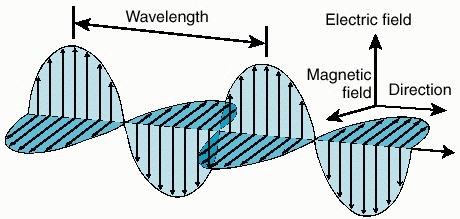 Electromagnetic radiation which contains both electric and magnetic fields
Electromagnetic radiation which contains both electric and magnetic fields
An Electromagnetic wave has both electric and magnetic fields. Light is an electromagnetic wave.
Generally, electromagnetic radiation is classified by wavelength into radio wave, microwave, infrared, visible region, ultraviolet, X–rays and gamma rays. The behavior of EM radiation depends on its wavelength and the amount of energy per quantum (photon) it carries.
 Electromagnetic spectrum
Electromagnetic spectrum
Radio waves have the longest wavelengths in the electromagnetic spectrum. These waves can be longer than a football field or as short as a football. Radio waves do more than just bring music to your radio. They also carry signals for your television and cellular phones.
Microwaves have wavelengths that can be measured in centimeters! The longer microwaves are the waves which heat our food in a microwave oven; these are good for transmitting information because microwave energy can penetrate haze, light rain and snow, clouds, and smoke. Microwaves, used for radar, are just a few inches long.
Infrared light lies between the visible and microwave portions of the electromagnetic spectrum. Infrared light has a range of wavelengths, just like visible light has wavelengths that range from red light to violet. "Near infrared" light is closest in wavelength to visible light and "far infrared" is closer to the microwave region of the electromagnetic spectrum.
Visible light waves are the only electromagnetic waves that are visible as the colors of the rainbow. Each color has a different wavelength. Red has the longest wavelength and violet has the shortest wavelength. When all the waves are seen together, they make white light.
Ultraviolet (UV) light has shorter wavelengths than visible light. These waves are invisible to the human eye, but some insects, like bumblebees, can see them.
X–rays have smaller wavelengths and therefore higher energy than ultraviolet waves. Generally we talk about X–rays in terms of their energy rather than wavelength. This is partially because X–rays have very small wavelengths. It is also because X–ray light tends to act more like a particle than a wave.
Gamma–rays have the smallest wavelengths and the most energy of any other wave in the electromagnetic spectrum. These waves are generated by radioactive atoms and in nuclear explosions. Gamma–rays can kill living cells, a fact which medicine uses to its advantage, using gamma–rays to kill cancerous cells.